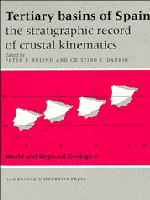Book contents
- Frontmatter
- Contents
- List of contributors
- Preface
- Dedication to Professor Oriol Riba IArderiu
- Memorial, Etienne Moissenet 1941–1994
- PART G GENERAL
- PART E EAST
- E1 Geological setting of the Tertiary basins of Northeast Spain
- E2 The lithosphere of the Valencia Trough: a brief review
- E3 Depositional sequences in the Gulf of Valencia Tertiary basin
- E4 Neogene basins in the Eastern Iberian Range
- E5 The Tertiary of the Iberian margin of the Ebro basin: sequence stratigraphy
- E6 The Tertiary of the Iberian margin of the Ebro basin: paleogeography and tectonic control
- E7 Stratigraphy of Paleogene deposits in the SE margin of the Catalan basin (St. Feliu de Codines – St. Llorenç del Munt sector, NE Ebro basin)
- E8 Onshore Neogene record in NE Spain: Vallès–Penedès and El Camp half-grabens (NW Mediterranean)
- E9 The Paleogene basin of the Eastern Pyrenees
- E10 The Neogene Cerdanya and Seu d'Urgell intramontane basins (Eastern Pyrenees)
- E11 Eocene-Oligocene thrusting and basin configuration in the eastern and central Pyrenees (Spain)
- E12 The Late Eocene–Early Oligocene deposits of the NE Ebro Basin, West of the Segre River
- E13 Chronology of Eocene foreland basin evolution along the western oblique margin of the South–Central Pyrenees
- E14 Evolution of the Jaca piggyback basin and emergence of the External Sierra, southern Pyrenees
- E15 Long-lived fluvial palaeovalleys sited on structural lineaments in the Tertiary of the Spanish Pyrenees
- E16 Evolution of the central part of the northern Ebro basin margin, as indicated by its Tertiary fluvial sedimentary infill
- E17 The Rioja Area (westernmost Ebro basin): a ramp valley with neighbouring piggybacks
- PART W WEST
- PART C CENTRE
- PART S SOUTH
- Index
E3 - Depositional sequences in the Gulf of Valencia Tertiary basin
Published online by Cambridge University Press: 04 August 2010
- Frontmatter
- Contents
- List of contributors
- Preface
- Dedication to Professor Oriol Riba IArderiu
- Memorial, Etienne Moissenet 1941–1994
- PART G GENERAL
- PART E EAST
- E1 Geological setting of the Tertiary basins of Northeast Spain
- E2 The lithosphere of the Valencia Trough: a brief review
- E3 Depositional sequences in the Gulf of Valencia Tertiary basin
- E4 Neogene basins in the Eastern Iberian Range
- E5 The Tertiary of the Iberian margin of the Ebro basin: sequence stratigraphy
- E6 The Tertiary of the Iberian margin of the Ebro basin: paleogeography and tectonic control
- E7 Stratigraphy of Paleogene deposits in the SE margin of the Catalan basin (St. Feliu de Codines – St. Llorenç del Munt sector, NE Ebro basin)
- E8 Onshore Neogene record in NE Spain: Vallès–Penedès and El Camp half-grabens (NW Mediterranean)
- E9 The Paleogene basin of the Eastern Pyrenees
- E10 The Neogene Cerdanya and Seu d'Urgell intramontane basins (Eastern Pyrenees)
- E11 Eocene-Oligocene thrusting and basin configuration in the eastern and central Pyrenees (Spain)
- E12 The Late Eocene–Early Oligocene deposits of the NE Ebro Basin, West of the Segre River
- E13 Chronology of Eocene foreland basin evolution along the western oblique margin of the South–Central Pyrenees
- E14 Evolution of the Jaca piggyback basin and emergence of the External Sierra, southern Pyrenees
- E15 Long-lived fluvial palaeovalleys sited on structural lineaments in the Tertiary of the Spanish Pyrenees
- E16 Evolution of the central part of the northern Ebro basin margin, as indicated by its Tertiary fluvial sedimentary infill
- E17 The Rioja Area (westernmost Ebro basin): a ramp valley with neighbouring piggybacks
- PART W WEST
- PART C CENTRE
- PART S SOUTH
- Index
Summary
Abstract
Well-logs and seismic lines from hydrocarbon exploration of the Gulf of Valencia can be analysed in the light of the concepts of sequence stratigraphy. Two major tecto-sedimentary stages are recognized: an early (Paleogene) continental molasse stage, which is correlative with the compressional deformation of the Iberian and Pyrenean mountain belts, and a later (Neogene) stage, marking the establishment of a marine foreland to the Betic Cordillera. Internal discontinuities in the continental molasse are results of changes in position and deformational kinematics of the compressional mountain fronts from which the sediments were derived. In the second stage, eight marine sequences are recognized. Seven of these contain only transgressive and highstand systems tracts. The eighth starts with a lowstand system tract, which is correlative with the Messinian unconformity. Detailed study of the sequences shows that the ‘Messinian Crisis’ was a brief climatic crisis, which was followed by a eustatic fall of sea level. During the climatic–eustatic events the Mediterranean Sea generally maintained a geometry and water depth very similar to the present.
Introduction
The Gulf of Valencia Basin became a geographically and geologically distinct entity with the tectonic emergence of the Balearic Islands during the Middle Miocene.
The present SW–NE orientation of the Basin (Fig. 1) is subparallel to the trend of the Betic Orogen (Lower Miocene), slightly oblique to the trend of the Catalan Coast Range (Upper Eocene), and perpendicular to the trend of the Iberian Range structures (Oligocene).
- Type
- Chapter
- Information
- Tertiary Basins of SpainThe Stratigraphic Record of Crustal Kinematics, pp. 55 - 67Publisher: Cambridge University PressPrint publication year: 1996
- 11
- Cited by



